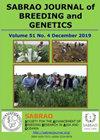开花一年生植物对不同营养管理的生产行为
IF 1.7
Q3 PLANT SCIENCES
引用次数: 0
摘要
万寿菊和百日菊在园艺工业中占有突出地位,在巴基斯坦广泛种植一年生开花植物。这项适时的研究旨在调查不同肥料组合对开花一年生植物万寿菊和百日菊的影响。该实验由完全随机设计组成,于2019年和2020年在巴基斯坦伊斯兰堡国家农业研究中心植物遗传资源研究所进行了四次重复。数据包括记录芽形成天数(DBF)、花持续天数(DFP)、单株花数(NFP)和花衰老天数(DFS)。基因型和处理之间存在显著差异。施用氮磷钾和叶面施用Grow More + HB101 + Vitafeed的平均DBF在研究第一年高于第二年。金盏花和百日菊的叶面施药效果为0.18 g Grow More + 0.18 g HB101 + 0.18 g Vitafeed。在20% N + 16% P + 14% K处理下,DBF金盏花的数量较高,而在NFP处理下,DBF金盏花的数量也较高。与氮磷钾和叶面施用相比,施用肥料的万寿菊和百日菊花的平均持续时间更长。75%的叶片堆肥+ 25%的土壤处理,两种植物的DFP均较高。有机和无机肥料可以促进植物健康,抵抗早花衰老,以及万寿菊和百日菊的大花大小。本文章由计算机程序翻译,如有差异,请以英文原文为准。
FLOWERING ANNUALS PRODUCTION BEHAVIOR AGAINST DIVERSE NUTRITIONAL MANAGEMENT
The marigold and zinnia are prominent in the horticulture industry and are widely growing flowering annuals in Pakistan. The well-timed study sought to investigate the effect of different fertilizer combinations on flowering annuals marigold and zinnia. The experiment comprised a completely randomized design with four replications during 2019 and 2020 at the Plant Genetic Resource Institute, National Agricultural Research Center, Islamabad, Pakistan. The data included recording days to bud formation (DBF), days to flower persistence (DFP), flowers per plant (NFP), and days to flower senescence (DFS). Significant differences were recordable among the genotypes and treatments. Average DBF under applications of NPK fertilizers and Grow More + HB101 + Vitafeed (foliar application) revealed higher during the first year of study compared with the second year. The most effective foliar application treatment for DBF of marigold and zinnia resulted in 0.18 g Grow More + 0.18 g HB101 + 0.18 g Vitafeed. A higher number of DBF marigolds occurred for treatment 20% N + 16% P + 14% K, and the same emerged for NFP. Average days for flower persistence in marigold and zinnia were higher under manures application compared with NPK and foliar application. The higher number of DFP of both plants existed for treatment 75% leaf compost (LC) + 25% soil. The organic and inorganic fertilizers may help develop plant health, resistance to early flower senescence, and large flower size of both marigold and zinnia.
求助全文
通过发布文献求助,成功后即可免费获取论文全文。
去求助
来源期刊

Sabrao Journal of Breeding and Genetics
农林科学-奶制品与动物科学
CiteScore
1.90
自引率
50.00%
发文量
63
期刊介绍:
The SABRAO Journal of Breeding and Genetics is an international journal of plant breeding and genetics research and was first published in 1969. It is the official publication of the Society for the Advancement of Breeding Research in Asia and Oceania (SABRAO).
Its objectives are to: promote the international exchange of research information on plant breeding and genetics, by describing new research findings, or ideas of a basic or practical nature; and be a medium for the exchange of ideas and news regarding members of the Society.
The Journal gives priority to articles that are of direct relevance to plant breeders and with emphasis on the Asian region. Invited for publication are research articles, short communications, methods, reviews, commentaries, and opinion articles. Scientific contributions are refereed and edited to international standards.
The journal publishes articles for SABRAO members mainly. The Journal preferred strongly that at least one author should be a current member of the Society. Non-members may also publish in the journal.
 求助内容:
求助内容: 应助结果提醒方式:
应助结果提醒方式:


